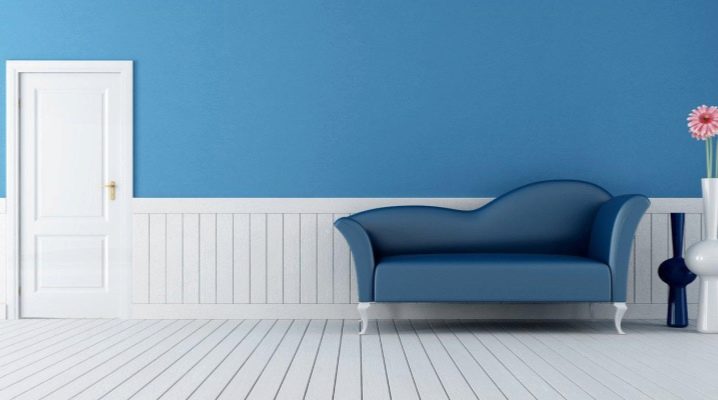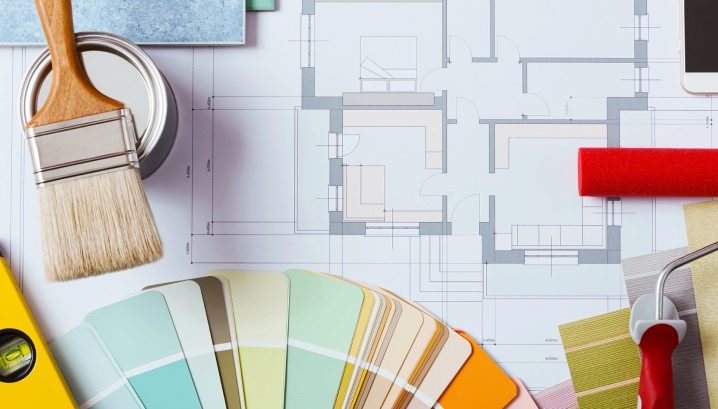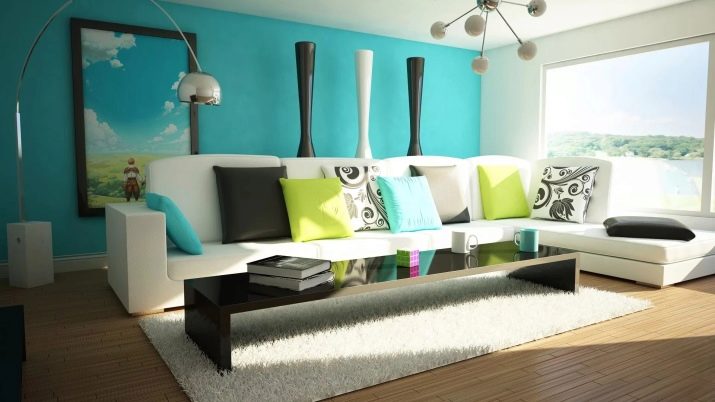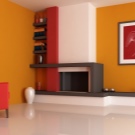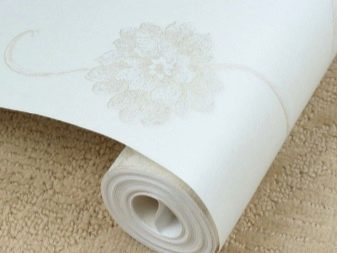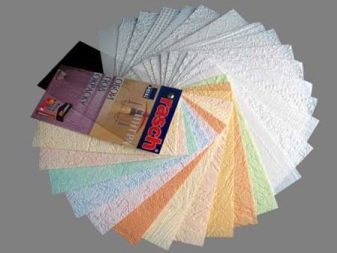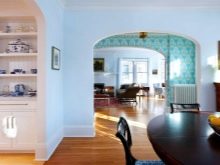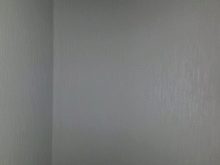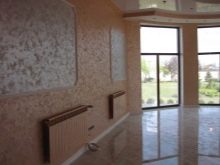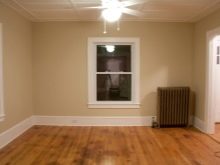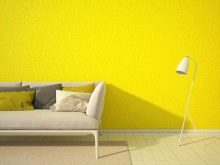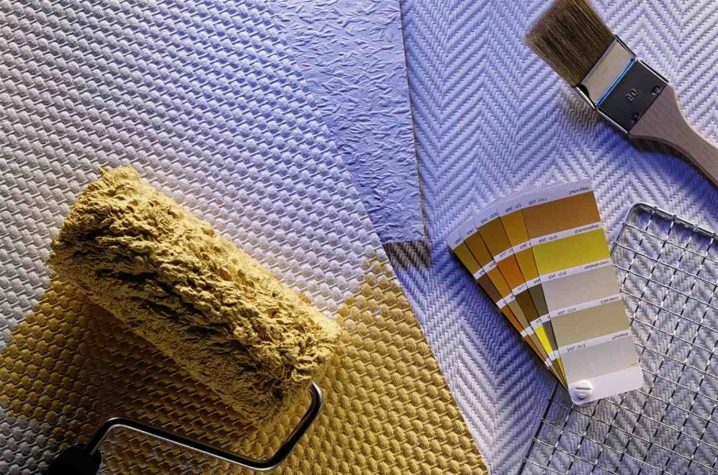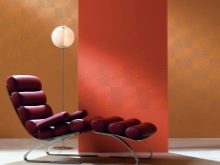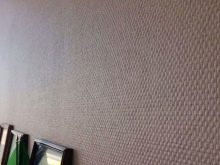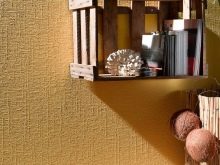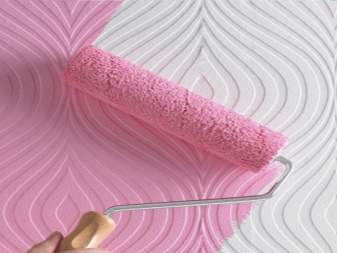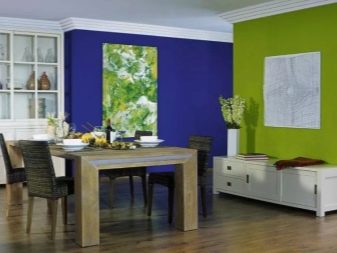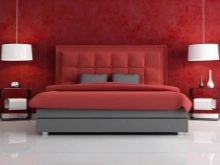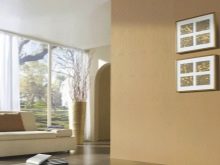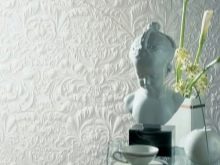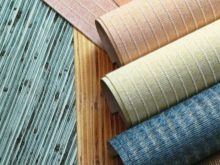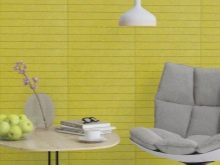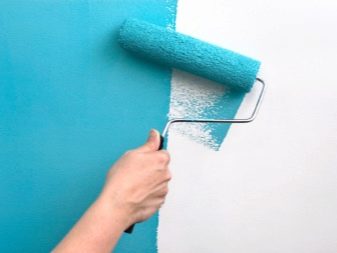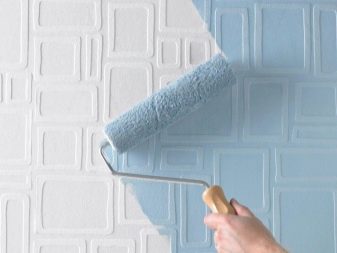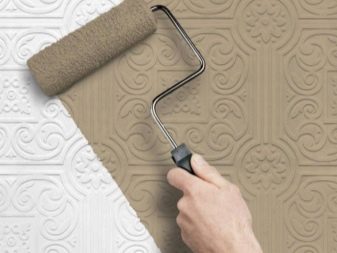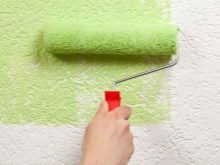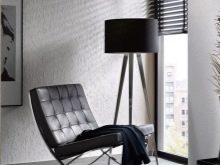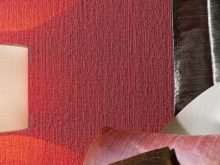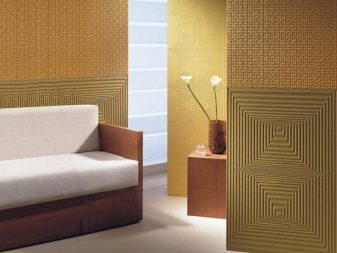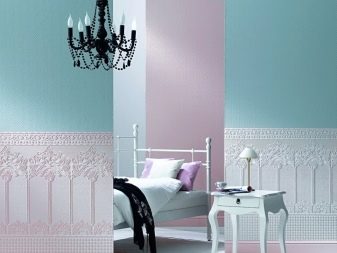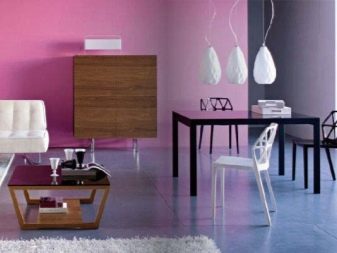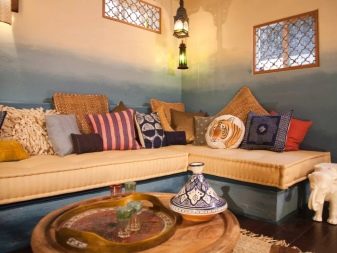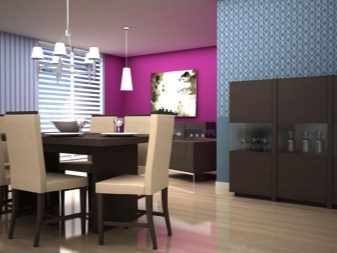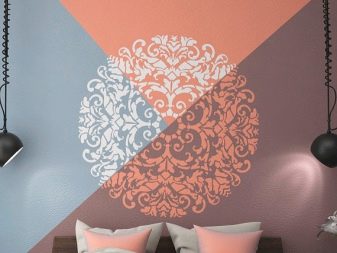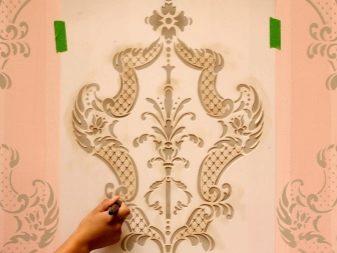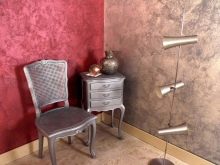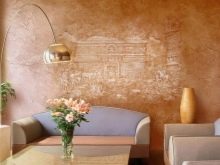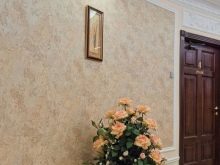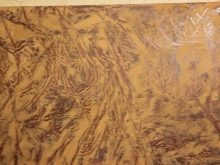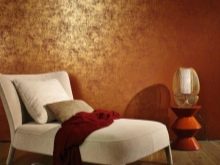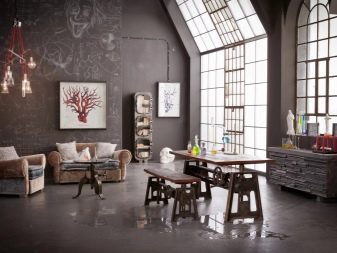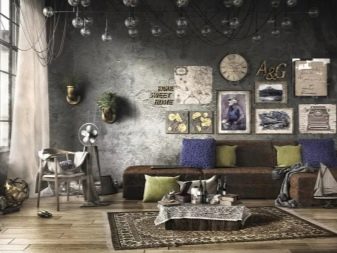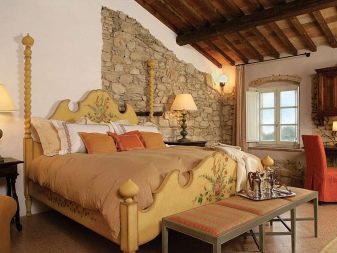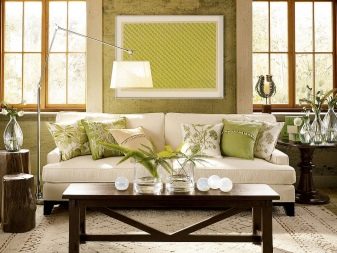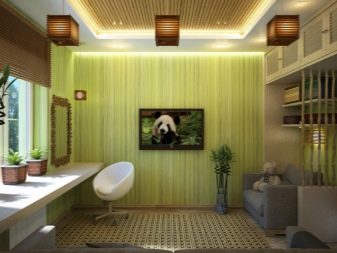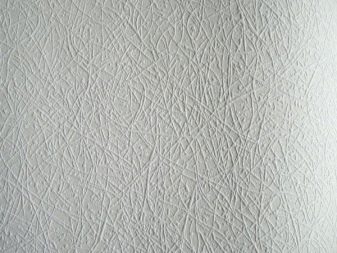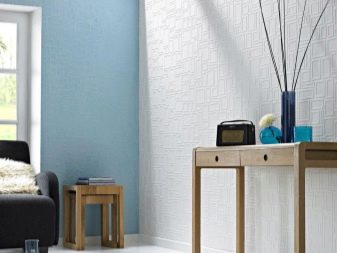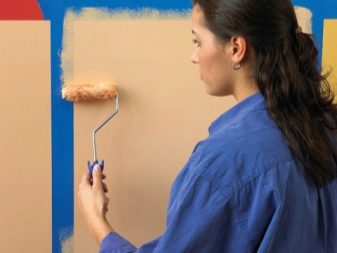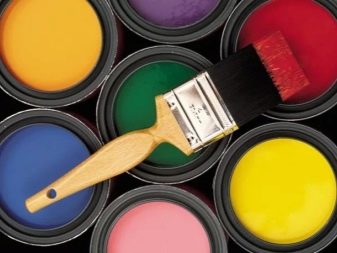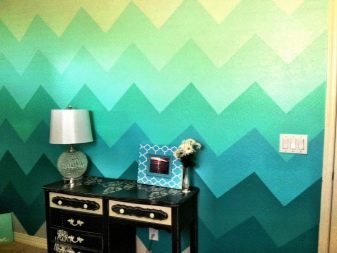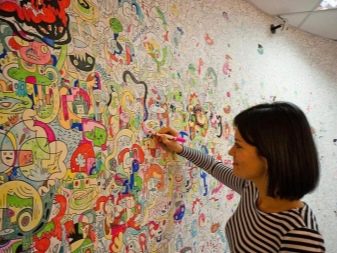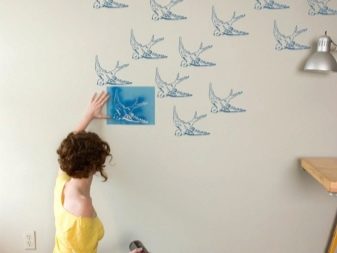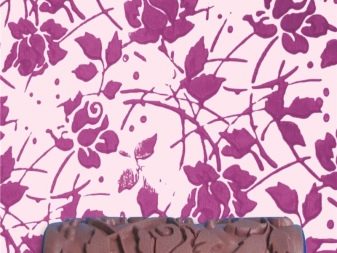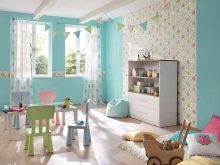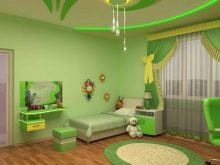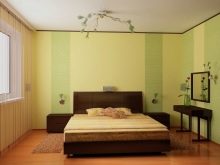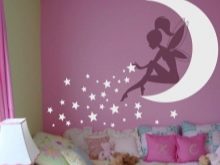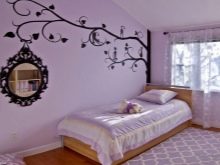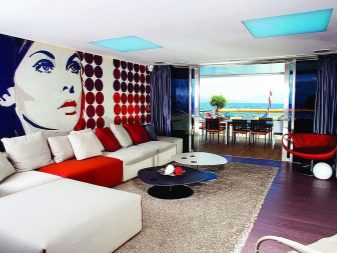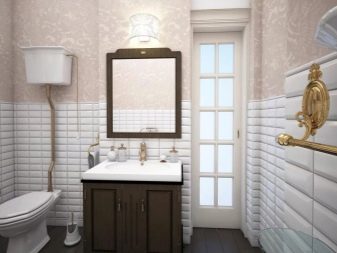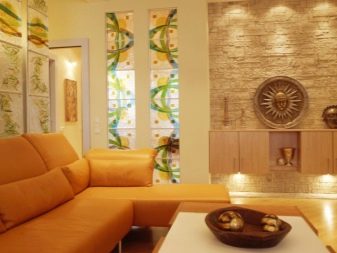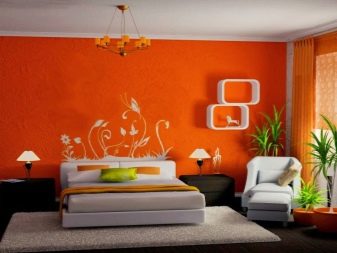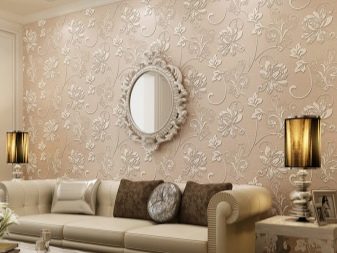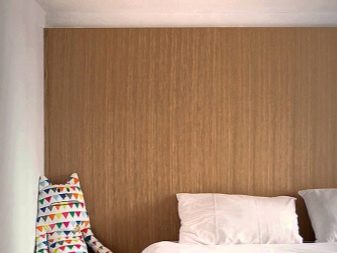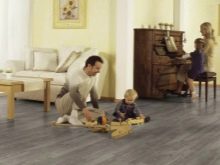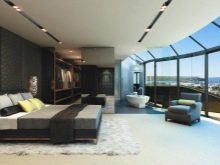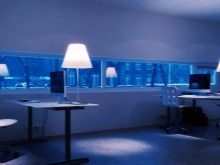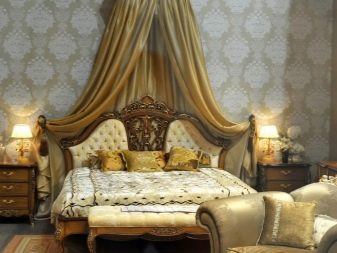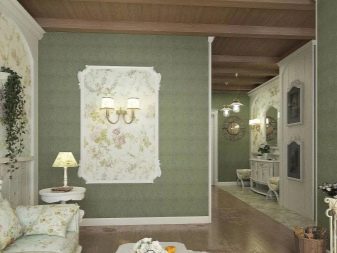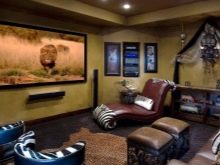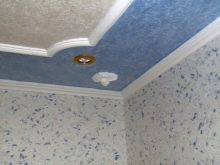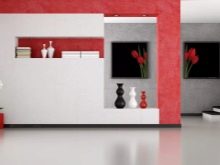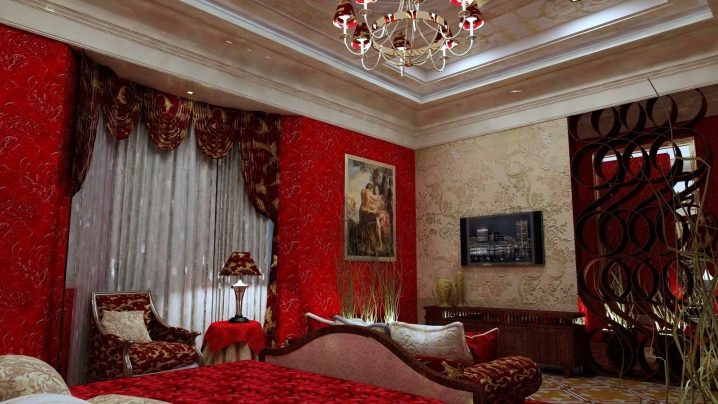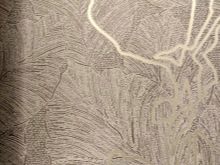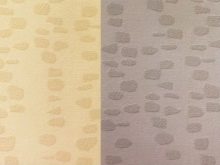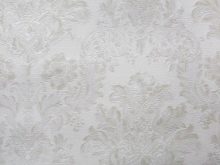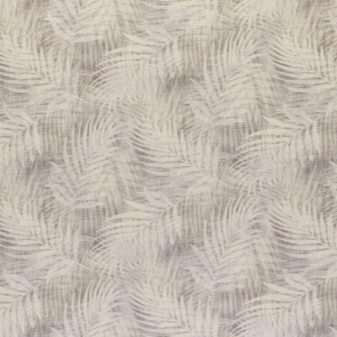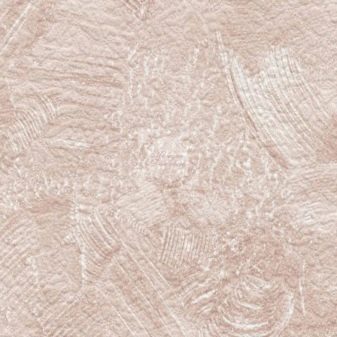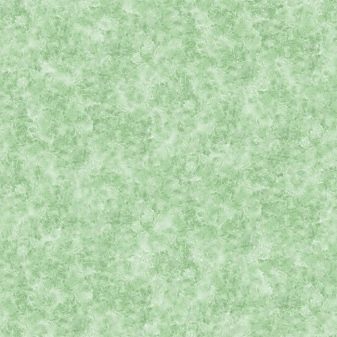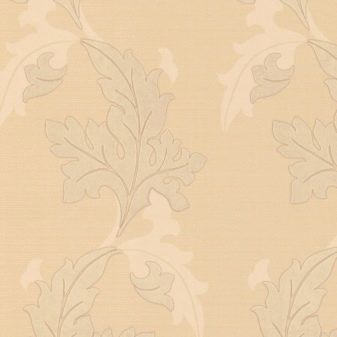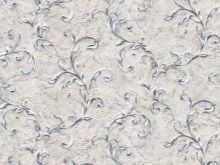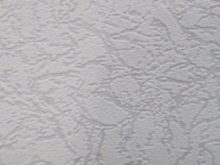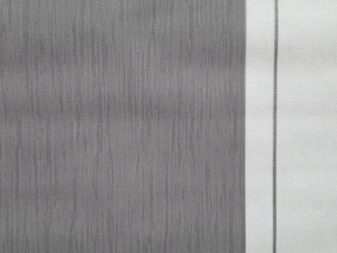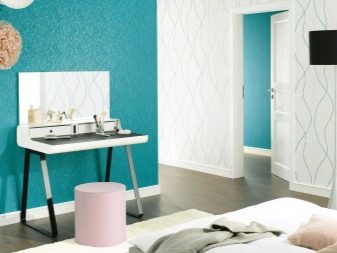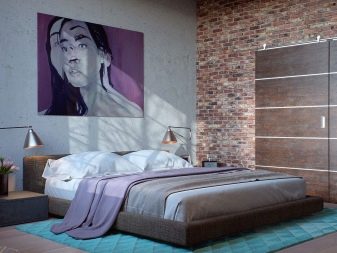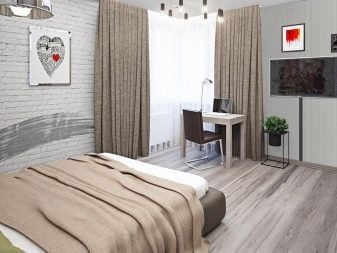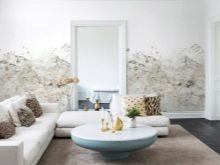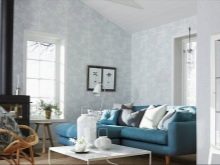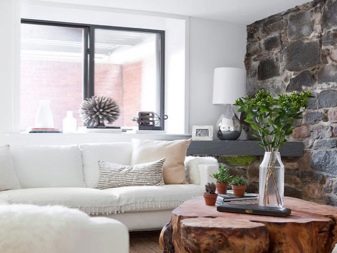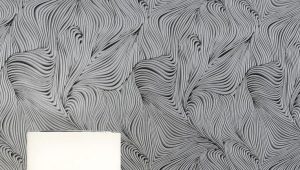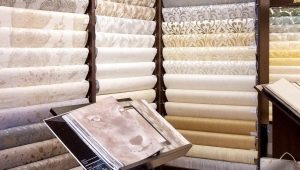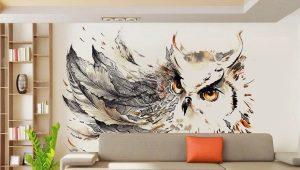Features wallpaper for painting
In our time, the construction market offers a variety of wallpapers of different types, textures and colors. Among them, a special place is occupied by models that can be painted. This property gives owners the ability to change color effortlessly several times.
What it is?
Some still believe that you can paint any kind of wallpaper, but this opinion is wrong. For coloring produce special types with certain characteristics:
- Moisture resistance. Wallpaper for painting process with special means, which increases their ability to hold the paint.
- The absence of multi-color pattern. As a rule, initially color is white or pastel shades.
- The presence of a relief top layer, which is needed not only for decorative purposes, but also to enhance the adhesion of the coloring composition with the surface of the wallpaper. They have another name - structural.
- Thickness is greater than that of ordinary ones, therefore, besides the immediate functions, wallpaper for painting can serve as heat protection and sound insulation.
- Environmental friendliness.
The cost of such finishing materials is available to a wide range of buyers. The advantage can be considered the possibility of repainting the walls without re-gluing the wallpaper.
Kinds
Manufacturers offer several basic types of wallpaper for painting. They are completely different, since different materials are used for manufacturing.
Paper
This type of finish is suitable for any surface, not just for walls. As a rule, they have a two-layer structure, sufficiently dense, which allows them to glue even surfaces that are not properly leveled. The paper view is considered to be the easiest. For its production, you can use waste paper impregnated with water-repellent substances. Embossing is obtained either by embossing or by applying a texture composition of sawdust or shavings between paper layers.
When sticking to the ceiling is usually used smooth species with a smooth surface.
Based on all the above characteristics, we can distinguish 3 main types of paper wallpaper:
- Simplex is a single-layered material with embossed or smooth texture.Simple, affordable, but has a short operational life.
- Duplex - a two-layer covering with a thick lower layer as a basis and decorative upper.
- The coarse fibrous texture resembles a coarse canvas, since there are chips in the composition.
The main advantages are low cost and environmental friendliness.
Among the disadvantages is to take into account the low moisture resistance and brittleness, so you need to handle them carefully and not glue in wet areas. Some users have noted the possibility of defects appearing during shrinkage. Repaint paper wallpaper is allowed no more than 6-7 times.
Glass fiber
A fiberglass base consisting of a mixture of quartz sand, dolomite, soda and lime is applied to a paper or fabric base. They are characterized by increased durability and strength, but, unlike the former, they are not able to hide defects on the surface. Concerning walls or ceiling must first be coated with a primer.
Relief glass wall paper has unusual structural patterns and bright patterns, so they have excellent decorative features.
Glass fabric wallpaper for painting in demand in offices and hotels, because they are durable, do not require frequent replacement and easy to clean. Experts pay attention to precautions when working with fiberglass materials, because when pasting small particles of glass can get on the skin and cause irritation. Allowed 10-12 repainting for the life cycle of the material.
Flizelinovye
One of the most common types in recent times are wallpapers on non-woven base. They are the most dense, because they have 2-3 layers and elastic. The relief structure is obtained by spraying polymers on the substrate. Smooth wallpaper can be glued to any surface and repainted up to 15 times. Non-woven wallpapers are great for repairs in new buildings, as they shrink due to the building’s shrinkage, they will help to keep the cracks that appear, they will not break and will not be deformed.
Smooth or indistinct textures are sometimes called “washable” because they can be easily cleaned with a damp cloth.
One of the varieties are vinyl wallpaper. They are distinguished by a decorative top layer made of foam or thick vinyl, so they have a pronounced relief. However, it must be borne in mind that the coating of the foam is quite fragile. The lifetime is usually limited to 10 years.
A special type of non-woven wall covering that can withstand mechanical stress should be highlighted. In the people they are called "anti-vandal." They can have a laminated outer layer resistant to abrasion. In this case, it is easy to eliminate any greasy stains, children's drawings and other contaminants.
Reinforced wallpaper will protect from animal claws, as well as suitable for use in public places: hotels, kindergartens, hospitals. For their manufacture, artificial and natural fibers are used at the base and a wear-resistant upper decorative layer, for example, Teflon.
Linkrust
Premium Coverage. Wallpapers are made from natural textile material, the surface of which is treated with a mixture of chalk, wax, rosin and wood flour. The section of the wall pasted over by them will please the eye indefinitely.
The number of repainting by the manufacturer is not limited. However, when painting it is necessary to take into account that the coating dries within two months.
Dimensions
Dimensions of wallpaper for painting are different from normal, they are larger.The most common dimensions are: 17x0.53 m, 25x1.06 m, 33.5x0.53 m and even 125x0.75 m.
Wide strips allow to reduce the number of joints, which makes the surface monolithic. For this reason, meter wallpaper is the most popular among buyers. According to reviews, they are able to facilitate and accelerate the process of gluing, especially with heavy non-woven coating options.
The length of the rolls for painting is almost 1.5-2 times longer than that of conventional models, which allows you to economize expensive material. The thickness of the wallpaper depends on its base. The thinnest, of course, single-layer paper.
The spongy structure of non-woven material is so dense and thick that it allows you to conceal defects in walls up to 5 mm. Dimensions manufacturers always indicate on the packaging.
Texture
A characteristic feature of the structural wallpaper - relief. However, it should be noted that smooth versions without texture are used less frequently. They usually have a fine-grained texture or are covered with a special "satin" composition.
The main advantage of the textured surface is that it feels like seamless, because the volumetric details make the joints invisible, a large width allows you to reduce their number or hide behind the details of the interior. Texture decisions can be different, but it must be remembered that with a wrong choice of relief can be felt monotonously and boring.
The pattern can be chaotic, orderly or repetitive. In the first case, a fine texture with rounded lines is better perceived. If the repeating pattern is complex and curved, then it will not quickly get bored. When choosing wallpaper for a strict classical interior, one should pay attention to simple and correct reliefs, with a low degree of repeatability.
Experts at the choice of structural finishing materials recommend to consider that the large ornament reduces the room, and small - expands.
Thin embossed paper wallpaper is easily glued and simply subsequently removed. As a rule, they are characterized by a small textural ornament, which will be appropriate in small rooms.
Coarse thick coatings give the surface a heterogeneous, natural look, which is highly appreciated by designers in eco-styles. Textured pattern on such models is the largest. Such wallpaper You should not glue in the corridors and other enclosed spaces.
Structural glass wall used for large public and office premises, often have a relief in the form of a cobweb, Christmas tree or mat. Dense non-woven models are able to visually imitate any materials: stone, brick, wood, textiles.
Design and colors
To give your own home individual notes, you need to approach the design of the walls and ceiling with interest. You can experiment with different shades, reliefs, texture, patterns.
Combined painting
Wallpapers allow you to combine and combine colors, but you need to do it correctly, considering the rules of the palette:
- It is better to combine neutral, gentle tones.
- Gradient is one of the extraordinary methods of transition from one color to another or a change in saturation with a uniform hue.
- Bright colors can also be combined, for example, orange and purple, yellow and blue, however, it is best to do this in spacious rooms.
For the premises of a small area, you can apply a horizontal color border that will visually expand them. It is standardly assumed that the lower part should be 1/3 of the wall, however, no one forbids retreating from this rule.
With the help of vertical color lines divide the space into functional zones. In addition, this effect visually "raises" the ceiling. Clear and beautiful borders between the color zones will help to arrange plaster or paper borders, mosaic or moldings.
A studio apartment will be transformed if its three walls are painted in light colors, and in the fourth one to focus attention with the help of a saturated bright color. Structural wallpaper can be painted in two colors. To do this, the base is stained with one shade, and on top of it a paint of another tone is applied on the projecting pattern. This method allows you to emphasize the relief structure and make a variety.
If the selection of contrasting colors present uncertainty in their abilities, then experts recommend using the services of professionals who can choose the optimal combination.
Figures on the walls
Monograms, circles, rhombuses and other figures are complex technology. In this case, the walls are plastered with smooth wallpaper without a structural pattern. They are covered with light, almost white paint, over which colored patterns are applied.To lay out the walls, you can use different materials at hand: masking tape, stencil, or draw a chaotic drawing manually with a brush.
Venetian plaster
Decorative plaster - one of the most sophisticated methods of wall decoration. It is expensive and requires skillful hands, so few can afford it. Manufacturers of wallpaper offer an excellent way out - wallpaper under the Venetian plaster. It is a non-woven coating coated with vinyl. Since the top layer-simulator is thick enough, the wallpaper perfectly repeats the multi-layered Venetian plaster with its unusual structure.
The advantages of the material are indisputable:
- Low cost.
- Self drawing on the wall.
- Moisture resistance.
- UV resistant.
- Wear resistance.
- Wide range of colors.
Stylish accents
In modern interiors, designers widely use materials that imitate various natural textures. This has become a trend lately.
The rules dictate the style, so wallpaper manufacturers produce a wide range of similar types:
- Loft-style wallpapers should maximize the physical properties of the walls.They can be concrete, brick, plastered. Surfaces "under a brick" are not uncommon in this interior direction, they are used more often than others. Usually the basis for non-woven wallpaper. As a rule, all the premises are not covered with such material, because it looks hard. Choose a central wall on which to focus attention. In the living room brickwork will look great next to the fireplace. Projections and niches can also be made in the form of a brick accent.
- Textured wallpaper "under stone, leather and wood" will perfectly fit into the interiors of country or the Middle Ages.
- The natural beauty of the eco-style design can be emphasized by wallpapers with imitations of various natural components: bamboo, papyrus, silk, and wood. In particular, these are the most popular types of glass wall paper, which have the texture "matting" or "canvas."
- Office and public premises are most often decorated with wallpaper in pastel colors, using all shades of light brown. They are characterized by the texture "herringbone" and "spider".
Dressing
Before you start painting, you need to wait for the wallpaper to completely dry.To create drawings, it is recommended to use a brush, for background application - a fur roller.
Paints
For each type of wallpaper apply their dye. Paper variants are better to paint with water-based paint, but if it is applied to non-woven, then there may be stains. Experts advise staining them with latex species. Acrylic or alkyd paints are suitable for glass wall coatings.
Ideas
Apply the paint as you like. On the Internet and on the pages of magazines you can find simple options and intricate design solutions. The most common ideas:
- Interesting drawings.
- Background monochrome and multicolor solutions.
- Graphics.
- Geometric ornaments.
Smooth wallpaper allows you to create original wall panels using hand-painted. To do this, they are given the desired background shade, and then applied a certain pattern with a brush or using stencils.
Shades
The color of the walls depends on the functional characteristics of the room and the desires of the owner. It is believed that for the nursery and the bedroom it is better to use pastel colors, fuzzy lines, restrained ornaments. but This rule does not exclude bright colors in the play area for children or saturated colors in the comfort zone. They can be combined, combined, which will allow to embody any design ideas.
Stencils
The ideal option, providing both ease of painting and obtaining exquisite decor, are stencils. The modern market offers a wide range of such products. The technology of application is so simple that even children can draw. The advantages of mass - affordability, simplicity and ease of coloring, the variety of ornaments, the opportunity to get an interesting exclusive decor with their own hands.
3D effect
Modern technologies allow using volumetric, almost holographic images in the interior. For this release wallpaper with a 3D effect. Models are quite expensive, but the sensations they create are worth it. Should remember that they are best used only for one surface in the room, as an accent.
Combining
Wall-paper is perfectly combined with other finishing materials. what can be used for decorative purposes:
- Ceramic tiles are most often used to decorate the walls in the bathroom or in the kitchen.When making walls with wallpaper for painting, details in the form of inserts, borders or wall panels made of ceramics look very impressive.
- Natural materials (marble, gypsum, wood, stone) look beautiful as additional decorative elements and are wonderfully combined with wallpaper.
Advantages and disadvantages
Wallpaper for painting has some advantages, which distinguish them from conventional types of coatings:
- High quality and environmental friendliness.
- Smooth coloring and fast drying.
- Resistance to various factors.
- The variety of shades that can be changed over time.
- Masking and binding wall cracks during shrinkage of the house, as well as other surface defects.
- The possibility of pasting both walls and ceilings.
- There is no need for special careful preparation of surfaces before sticking wallpaper.
- Glue is applied to the wall, not to the canvas, which saves and reduces repair time.
- Wear resistance and durability.
It may be noted some shortcomings:
- Difficulties with painting the surface with large terrain.
- Some types of wallpaper have a fragile structure before dyeing, so you need to glue with caution.
- Glass fiber wallpaper requires care when applied to walls, as their small particles can cause skin irritation.
- Foamed vinyl wallpaper can peel off and are easily scratched.
Which is better to choose?
The choice of wallpaper for painting depends on the functional characteristics of the room, the surfaces to be glued and the nuances of the interior.
Depending on the room:
- When buying in offices and other crowded premises, it is better to give preference to durable and wear-resistant coatings resistant to mechanical damage. In this case, professionals recommend non-woven or glass cloth wallpaper.
- For use in an apartment with a small number of residents, paper types are acceptable. However, in the corridors and in the kitchen it is better to give preference to “washable” options.
- Apartments in which families with small children or animals live are better decorated with anti-vandal non-woven wallpaper, and laminated versions would also be appropriate.
- Fiberglass wallpaper will be appropriate for the bathroom, as they are the most moisture-resistant and breathable, so fungus and mold are rarely used on them.It is better to paint them with acrylic or latex dyes that are suitable for wet rooms. If you choose the coloring composition marked "washable", you can significantly improve the technical characteristics of the canvas.
- For a living room or a room, wallpaper should be selected based on the general concept of the room:
- Classic style - the coating is characterized by a large number of ornaments and reliefs. Surfaces can be glossy and matte. Coarse-fiber thick wallpaper with a large relief pattern and a combined coloring are suitable for wall decoration.
- Modern uses a combination of inconspicuous tones, smooth lines and elegant ornaments. In this case, glass fiber wallpaper and non-woven linen look great.
- Provence is distinguished by simplicity: a small textured pattern of walls with floral patterns, warm shades.
- Ethnostil - the most diverse, depending on the specific subject. For example, Japanese motifs suggest the imitation of walls made of natural materials, so it is better to use glass fabric coatings, repeating the texture of rice paper, silk, bamboo, matting. Most often, wallpaper is a background color, drawings are applied by hand using stencils in the form of hieroglyphs, sakura, cranes.
Production of materials is carried out in different conditions, so the characteristics of different types and manufacturers will be individual
Depending on the type of surface:
- Walls can be plastered with any type of canvases. The main thing is that they respond to the functionality of the room. It is very important to choose the right color scheme, depending on the location of the windows. If they are northern, then, as a rule, there is a lack of sunlight in the room, so it is better to choose wallpaper of warm tones: yellow, coffee, golden. For southern orientation of windows, give preference to cold colors: gray, blue and blue.
- Ceiling. As a rule, ceiling materials are represented by thick vinyl or non-woven wallpaper. They perform not only a decorative, but also a protective function against the flow of water from the upper floor.
- Ledges and niches. These sites will help to place accents, to pay attention to the individual details. Designers often use wallpapers for them that are different from basic coatings to emphasize style. From the point of view of practicality, it is better to draw them with canvases with soft, stretching bases, since the projections and niches have complex surfaces with many faces and corners.
Features of choice:
- It is difficult to choose wallpaper in absentia, since the screen and the photo cannot accurately convey the relief and color. Structural models are sometimes better to feel tactile.
- It is better to clarify all the operational qualities of the material from the representatives of the company in advance.
- Wallpaper for painting requires a certain type of dye, so this point must first be clarified.
- If the products have a quality certificate, the manufacturer maintains its reputation, then you can hope to purchase quality material.
- Experts recommend choosing wallpapers from one collection, as they are better in harmony and blend together.
Famous manufacturers
The wallpaper market offers a wide range of products for every taste. There are more and more manufacturers every year. When choosing a wallpaper for painting, experts advise to give preference to firms with an excellent reputation and give a guarantee on their products.
As for quality, then European brands have no equal. As a rule, foreign enterprises are focused on the production of elite, expensive finishing materials. using thickened paper or cloth as a base:
- For example, German brands Marburg, AS Creation, Erfurt and Erismann produce premium wallpapers.
- French (Mermet) and Swiss (Mitex and Tasso Glass) brands have remarkably established themselves.
- Equally popular and in demand are wallpapers made in Belgium (Arte) and Finland (Fintex).
If there is a desire to paste over walls with material for painting, and the budget is limited, then you can turn to the markets of Russia or the CIS. By design, our firms are not inferior to foreign ones. The most famous are such factories:
- "Palette".
- Moscow wallpaper factory.
- "Saratov wallpaper."
- "Art".
Belarusian companies are not far behind in popularity and budget:
- "White-sided".
- "Gomeloboi".
- Dobrosenskaya factory "Hero of Labor."
When choosing wallpaper, it is necessary to read reviews in order to acquire not only relatively cheap, but also a sufficiently high-quality option. For example, if you know in advance information about the branches of foreign firms whose production is located in Russia, then You can significantly save on this.
The German company Erismann manufactures products not only from German factories, but also from the Moscow-based factory in Voskresensk.
Ideas and options in the interior
Interior solutions using wallpaper for painting allow you to choose from the variety of the best option for a particular dwelling. The modern market offers fashionable decorative materials, with which you can make a variety in the interior, giving it originality, individuality and aesthetics.
Recent fashion trends include designs in the style of dilapidated old attics and warehouse space. First of all, it should be noted that the areas decorated in the loft style are characterized by high ceilings and a minimum number of interior partitions.
Urban atmosphere is achieved by many details, including unique wallpaper:
- Bare concrete and brick wall.
- Crushed tile or old shabby tree.
The most decorated walls are decorated with different types of paintings. Their heterogeneity creates a natural look, inherent in industrial style.
Scandinavian style is characterized by an abundance of details in a light, almost white color scheme. It should be noted that in this case, porcelain, slightly grayish, pearl with delicate tints, beige and milky shades are popular.Since the direction is aimed at naturalness, wall decoration involves wallpaper with imitation of natural materials: wood and stone. Here fit non-woven wallpaper with vinyl embossed coating. In addition to a clear texture, sometimes use fine-grained or smooth matte surface.
Some design trends are popular and in demand, regardless of modern trends. These include modern - universal, concise, elegant, bordering on luxury. The main characteristics of the wallpaper for painting - the brightness and asymmetry of the patterns, simple monophonic background. An imitation of masonry or under the skin, as well as unusual textural solutions for canvas, sand, and plaster serve as a stylish addition.
Designers often use gloss effectwhich, thanks to sunlight, create a unique atmosphere. The basic shades are considered light colors (white, caramel, beige, gray), however, inserts or transitions of saturated color will emphasize the elegance of the style.
High tech. The hallmark of the style is the presence of steel, glass elements and textures.In this regard, choose a wallpaper for painting without brightly highlighted patterns. The main thing - non-standard texture and additional effects in the form of gloss, gloss and metallic shades. Designers advise to give preference to monophonic variants with an inexpressive pattern. Lines must be strict, precise and clear.
Experts claim that in the design there is nothing not possible. Wallpaper glue and paint can be on their own, without attracting additional paid human resources. The main thing is the desire, the availability of all the required materials, a clear plan of action and project.
On how to properly paint the wallpaper, learn from the professionals in the next video.
